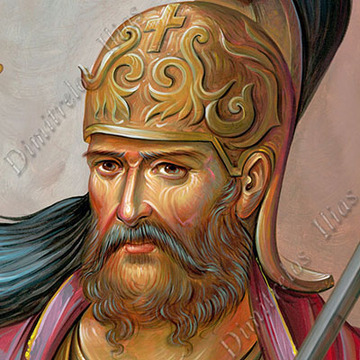Also known as:
Constantine Palaeologus, Konstantinos Palaiologos, Κωνσταντίνος Παλαιολόγος
More People of Greece
More Topic Categories
Related Destinations
Contantine Palaiologos (08/02/1404 - 29/05/1453)
 Constantine XI Palaiologos was the last Byzantine Emperor, whose heroic fight against the Ottomans marked the end not only of his dynasty, but of a whole era and the Byzantine Empire.
Constantine XI Palaiologos was the last Byzantine Emperor, whose heroic fight against the Ottomans marked the end not only of his dynasty, but of a whole era and the Byzantine Empire.He was the son of Emperor of Manuel II Palaiologos and Jelena Dragas, daughter of the Serb lord of Serres. At a young age, he was assigned the management of cities in Pontos. In 1427, Constantine arrives in Mystras to help his brothers at liberating Peloponnese from Francs. Two years later, he besieges Patra and liberates it too. In 1432, with the exception of four cities, the rest of the Peloponnese is in Byzantine hands and Constantine rules over Kalavryta. He returned to Constantinople in 1435 and he soon went to Italy to participate in the efforts to unite the Catholic and Orthodox Churches. In 1443, he became despot of Mystras and tried to reorganize it militarily and administratively. He fortified the walls of Isthmus and captured Voiotia and Fokis. However, a strong attack by the Ottomans resulted in Constantine pleading for peace, and becoming a vassal to the sultan.
He became emperor while in Mystras in 1449, and returned to Constantinople, full of hope and fear for the future, as the Turkish threat turned its gaze towards the city. He reformed the army, and made fortifications, but that was not enough to counter the might of the Ottomans or the ambition of the new sultan Mehmed II. Constantine asked for help by the West, but he was met with indifference. On 28 May 1453, Mehmed commanded the final attack against Constantinople. Constantine tried to boost the morale of the army, and the first wave of the attack was successfully defeated. However, the Turks broke the defenses and entered the city on 29 May.
Constantine XI fought valiantly among his soldiers and fell. Mehmed II ordered that he be buried according to the royal protocol, but the place of burial was not announced. As a result, a legend was created and Constantine became the “Marble King”. According to the legend, when the king was surrounded by Turks, an angel took him, turned him into marble, and hid him in a cave. So, when the time comes, at the “fullness of time”, the angel will return to give Constantine his life back, so he may yield his sword and drive the Turks out of Constantinople. Another legend has it that he will chase them to the “Red Apple Tree”, a legendary place, where they will be killed; so, the Turks constantly search for the cave where the Marble King is hidden, but they cannot find it because the angel protects him.
Four centuries later, during the Greek Revolution of 1821, the Greeks had Constantine’s legend as a rallying cry. Today, the Emperor is considered a national hero and has been used many times as the main theme in various Greek cultural activites.
See Also:
 Athens Photos
Athens Photos
 Santorini Photos
Santorini Photos
 Crete Photos
Crete Photos
 Meteora Photos
Meteora Photos
 Corfu Photos
Corfu Photos



